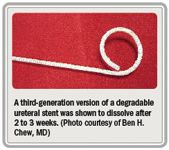Article
Degradable and drug-eluting stents: Mixed results
Author(s):
Researchers developing a degradable ureteral stent report progress with their project that supports moving forward into clinical trials.

At the 2009 AUA annual meeting, Ben H. Chew, MD, assistant professor of urology at the University of British Columbia, Vancouver, and colleagues presented their experience with a first-generation degradable stent (Poly-Med, Anderson, SC) that dissolved 7 to 10 weeks after placement in a porcine model. Aiming to develop a device with a shorter longevity, they modified the polymer content and, in a third-generation attempt, came up with a stent that dissolved after 2 to 3 weeks and was easier to insert as well.
Biocompatibility studies showed a trend for less edema and inflammation with the degradable stent compared with a conventional stent. In addition, urine flow, as determined by intravenous pyelogram, was faster in animals implanted with the biodegradable stent, and renal ultrasound showed no evidence of hydronephrosis.
"Now it will be important to investigate stent degradation, safety, and tolerability in clinical trials."
Researchers at the University of British Columbia are working on this project in conjunction with scientists at Poly-Med, and they are seeking funding for clinical trials.
Drug-eluting stent: Potential benefits
Results on the use of a ketorolac-eluting ureteral stent (Boston Scientific, Natick, MA) were reported in two studies. Dr. Chew and John D. Denstedt, MD, of the University of Western Ontario, London, reported findings from a preclinical study in a porcine model that showed the drug-eluting stent provided high levels of ketorolac at the target tissue with undetectable plasma levels, reducing the potential for systemic side effects. Ureteral tissue levels were 11-fold higher in animals implanted with the drug-eluting stent than in those that were administered oral ketorolac.
Results of a multicenter clinical study were reported by Amy E. Krambeck, MD, who was involved in the trial as an endourology fellow at Methodist Institute for Kidney Stone Disease, Indianapolis. The trial randomized 276 patients who had undergone diagnostic ureteroscopy or uncomplicated ureteroscopy for stone disease to receive the drug-loaded stent or conventional control. Depending on surgeon preference, all stents were left indwelling for 4 to 10 days.
The primary efficacy endpoints were unscheduled office visits, changes in medications, or early stent removal; the secondary efficacy endpoints were pain medication use and pain visual analogue score (VAS) ratings. There were no significant differences between study groups in the primary or secondary efficacy endpoints, and adverse events were also similar between cohorts.
However, subgroup analyses with patients divided by gender and age suggested benefits in younger men. Men who received the ketorolac-loaded stent were more likely to require no or minimal pain medication during the first 4 days compared with men with the control stent and women in both groups. In addition, the differences were statistically significant on days 3 and 4 after stent placement.
In the age analysis, pain medication use was generally lower among patients younger than 45 years than among their older counterparts, although the difference showed only a trend toward statistical significance.

















